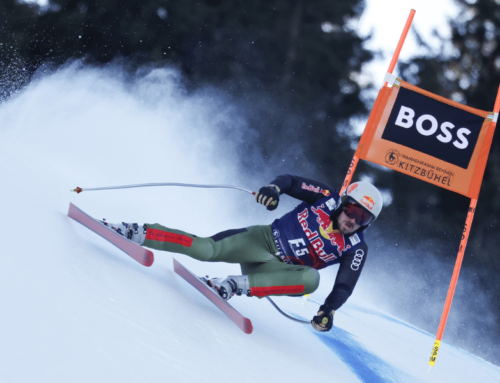Self-Assessment for the Serious Skier
Self-Assessment for the Serious Skier Winter is around the corner, and you’ve been dryland training all summer and fall. You’ve been working on cardio with mountain biking and in-line skating, your lunges and squats are works of art, and you’re a living testimonial to plyometric training. What else could you possibly need before that first flake falls?
Winter is around the corner, and you’ve been dryland training all summer and fall. You’ve been working on cardio with mountain biking and in-line skating, your lunges and squats are works of art, and you’re a living testimonial to plyometric training. What else could you possibly need before that first flake falls?
At the risk of sounding Zen, the answer lies within yourself.
While most of today’s pre-season training programs are quite sophisticated, there is no benchmark to let an athlete know if he or she has done enough preparation. Simply put, it’s your body’s ability to work as a unit that determines how prepared you are for intense skiing. If your musculature is not symmetrical, then your ability to resist forces like gravity and momentum will be compromised. When you catch an edge or make a hard landing, your weak side is likely to fail.
A series of balance, excursion and jump tests – performed on one leg at a time – will allow you to assess your personal weaknesses. Look for discrepancies between your right and left sides, and address them by using the test themselves as stengthening/balance drills. By incorporating the tests into your training program, you’ll develop skills that will directly enhance your skiing.
In the pre-season, if a drill shows an imbalance, then you should do that drill on the weaker side at least three times per week, incorporated with your normal land workouts. A re-test after 2 weeks will reveal how much improvement you’ve made – continue the drills until the re-test shows muscular balance.
During the race season, maintain your symmetry by doing these drills once a week.
The testing should be always conducted in a safe environment and should cause no pain. If you are rehabbing from an injury, please consult your physical therapist before undergoing any of these tests.
Self-Assessment Tests
Balance test #1: Stand on one leg with your back toward the wall, about 18 inches from the wall. With both arms, reach overhead and touch the wall. If successful, then take a small step forward and repeat until you come to failure. Mark the distance of your furthest reach. Repeat with your other leg, then compare the two distances.
Balance test #2: Stand on one leg and reach with the same-side arm to the ground behind you by turning at a 45-degree angle. Mark the distance, them repeat on the other side.
Excursion lunge test: Stand on one leg, lunge to the side with your arms reaching out at waist height. Mark the greatest distance of three trials that you can successfully perform the lunge and still return successfully to starting position. Compare both sides.
Timed lunge test: Stand on one leg, do a reverse lunge by squatting on the stance leg and reaching back to tap the opposite foot on a mark set about 4 feet from stance heel. Count how many successful taps you can perform within one minute. Repeat for opposite side.
Jump distance test: Stand on one leg; jump forward with a 90-degree rotation to the same side. You must be able to stick the landing and hold it for a total of 5 seconds. Measure the farthest distance. Repeat for opposite side.
Jump timed test: Start on one leg, mark your starting point, and then mark a 3-foot distance at a 45-degree angle in front of you. Count how many successful jumps you can make between the marks within one minute. Repeat with opposite leg.
You will likely notice a pattern of weakness on one side versus the other as you perform these tests. Most people will find some level of asymmetry, but the goal of perfect balance is attainable.
In the first balance test, a difference between sides may mean a tight hip flexor that is inhibiting your control. With the lunge tests, a marked difference in distances or amount of lunges per time may show a weakness or lack of control in one side versus the other. In the excursion lunge test, a tight calf might limit the depth of your lunge by limiting how much your ankle will allow you to sink down. Your quality of movement may deteriorate quickly when doing a timed test, showing a lack of endurance. A poor jump test will show an inability to control the forces of momentum. You may want to do the tests with a partner who can give you feedback on the quality of your control, which can show an imbalance even if the measurement is the same.
As mentioned above, tight or inflexible muscles can affect your mechanics enough to hamper your explosive power and your agility on the slope, thereby affecting your reaction time. The typical tight nesses that skiers contend with are in a large part due to the posture of skiing. The tucked position will tend to cause tight hip flexors (Psoas muscle) and tight hamstrings, and the fixed position in the boot can cause tight calf muscles, particularly of the Soleus.
A good stretching program requires that you hold the stretches statically for 45 seconds each, twice a day. These three stretches are extremely beneficial for skiers:
Hip flexor (Psoas) stretch: Stand in a tall posture facing a wall, place one leg behind you and rotate it inward as much as you can. Then lean the same side of your pelvis toward the wall while keeping your upper body parallel to it. Tighten you butt and abdominals to feel the full stretch in the front of your hip, almost in the groin area. Repeat with the other leg.
Hamstring stretch: Lie on your back and bend one knee toward your chest. Then, use a towel or belt around heel to pull you foot toward your head. Keep the extended knee slightly bent so you do not risk overstretching the sciatic nerve.
Calf (Soleus) stretch: Face a wall and stand about arm’s distance away. Place one foot a good distance behind you, and position your front foot to the inside of it, so that the feet are crossed. Place your hands on the wall to keep your upper body parallel, and then sink your whole body by bending at the knees. This is different than the typical calf stretch (for the Gastrocnemius) where the back leg stays straight and you lean forward onto the front leg and you feel through the whole muscle.
Now that you have the information to detect imbalances in your body, you have the advantage to work on discrepancies before you hit the slopes. Save all of your measurements, so you can retest yourself throughout the season.
———-
Laura Keller, M.P.T. works with Kevin R. Stone, M.D. and the entire rehabilitation team at The Stone Clinic, in San Francisco, California. She can be reached at 415-563-3110, or laura@stoneclinic.com. Visit www.stoneclinic.com for more information.





















